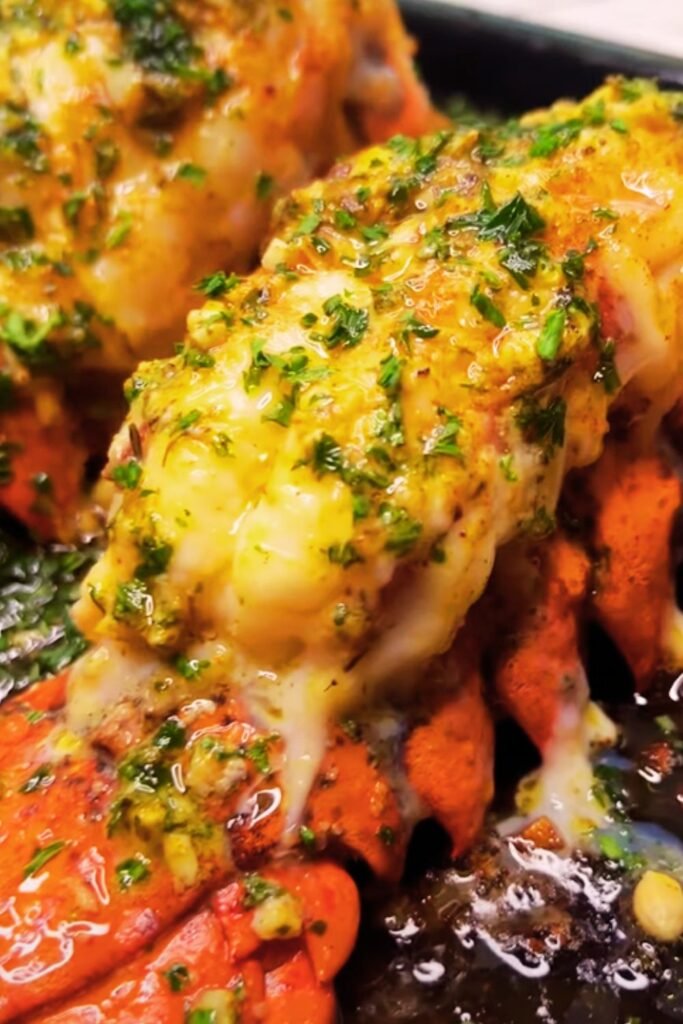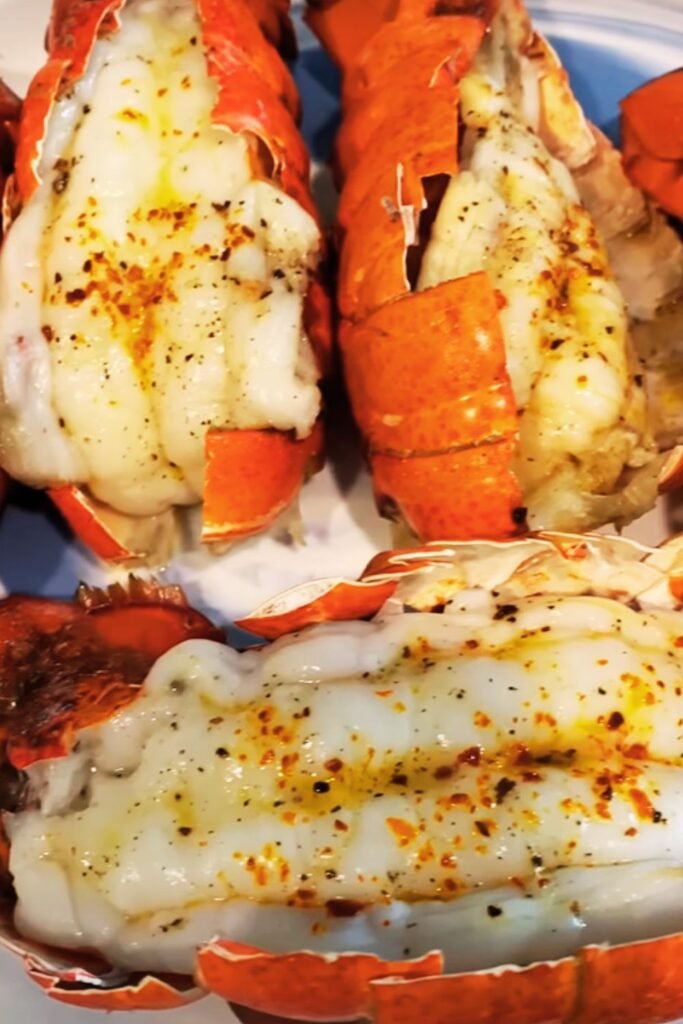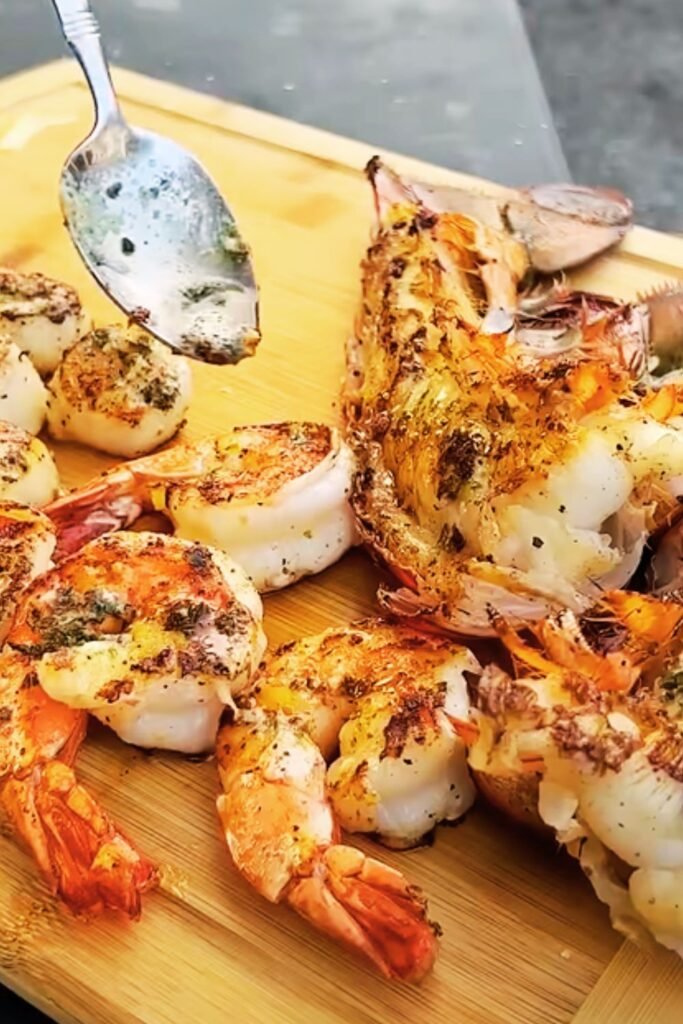Have you ever wanted to recreate that luxurious steakhouse experience at home? I’ve spent years perfecting my lobster tail recipe, and I’m thrilled to share my secrets with you today. Baked lobster tails might seem intimidating, but I promise they’re one of the easiest gourmet meals you can make. With just a few simple ingredients and about 20 minutes, you’ll have a restaurant-quality dish that will impress anyone lucky enough to join you at the dinner table.
Why You’ll Love This Recipe
There’s something magical about the combination of sweet, tender lobster meat and rich, melted butter. As someone who’s tried countless cooking methods, I can confidently say that baking lobster tails is the most foolproof way to achieve that perfect texture—tender and succulent without being rubbery. The gentle heat of the oven allows the lobster to cook evenly while preserving its natural sweetness.
What makes this recipe truly special is the garlic butter sauce that infuses the lobster meat with incredible flavor as it bakes. It’s a simple preparation that delivers spectacular results, making it perfect for special occasions or whenever you want to treat yourself to something extraordinary.
Ingredients You’ll Need
For the perfect baked lobster tails, quality matters. Here’s what you’ll need to serve 4 people:
- 4 lobster tails (5-6 oz each), fresh or frozen and thawed
- 8 tablespoons unsalted butter (1 stick)
- 4 cloves garlic, minced
- 1 tablespoon fresh lemon juice
- 1 tablespoon fresh parsley, chopped (plus more for garnish)
- 1 teaspoon paprika
- ½ teaspoon sea salt
- ¼ teaspoon white pepper
- Lemon wedges for serving
Understanding Lobster Tails
Before we dive into cooking, let’s cover some basics about lobster tails that will help you shop wisely and prepare them perfectly.
Types of Lobster Tails
- Cold Water Lobster Tails: These come from Maine, Canada, or New Zealand and have whiter meat that turns opaque when cooked. They’re generally more expensive but have a sweeter, more tender texture.
- Warm Water Lobster Tails: Sourced from the Caribbean, Florida, or Latin America, these tails have meat that’s more yellowish or grayish. They’re typically less expensive and have a slight fishier taste.
For this recipe, either type works beautifully, though I personally prefer cold water tails when I can find them.
Fresh vs. Frozen
While fresh is always wonderful, high-quality frozen lobster tails are perfectly acceptable and much more widely available. Most “fresh” lobster tails at grocery stores were previously frozen anyway. The key is proper thawing, which I’ll cover in the preparation steps.
Equipment Needed
- Baking sheet or oven-safe dish
- Parchment paper or aluminum foil
- Sharp kitchen scissors
- Small saucepan
- Pastry brush
- Instant-read thermometer (optional but helpful)
- Seafood picks or small forks (for serving)
Preparation Steps
How to Thaw Frozen Lobster Tails
If using frozen lobster tails, proper thawing is crucial for the best results:
- Place the frozen lobster tails in the refrigerator 24 hours before cooking.
- For quicker thawing, place them in a sealed plastic bag and submerge in cold water for 30-60 minutes, changing the water every 15 minutes.
- Never thaw lobster tails at room temperature or in hot water, as this can promote bacterial growth and affect texture.
How to Butterfly Lobster Tails
The presentation of butterflied lobster tails is stunning, and it also helps the meat cook evenly. Here’s my step-by-step approach:
- Using sharp kitchen scissors, cut through the top shell (not the underside) lengthwise, starting from the open end and stopping just before the tail fin.
- Carefully slide your thumb between the meat and the shell to loosen it.
- Gently pull the meat up through the cut, keeping it attached at the tail end, and let it rest on top of the shell.
- If desired, you can remove the vein (digestive tract) that might be visible along the top of the meat.
- For the iconic “lobster tail curl,” insert a wooden skewer lengthwise through the meat to keep it from curling too much during baking.

Detailed Cooking Instructions
Now that your lobster tails are prepped and ready, let’s move on to the cooking process:
- Preheat your oven to 425°F (220°C). Line a baking sheet with parchment paper or foil for easier cleanup.
- Prepare the butter sauce: In a small saucepan over medium-low heat, melt the butter. Add the minced garlic and sauté for 1-2 minutes until fragrant but not browned. Remove from heat and stir in the lemon juice, chopped parsley, paprika, salt, and white pepper.
- Arrange the butterflied lobster tails on your prepared baking sheet, meat side up.
- Brush the lobster meat generously with the garlic butter mixture, making sure to get some into the crevices between the meat and shell. Reserve about 1/4 of the butter mixture for serving.
- Bake the lobster tails in the preheated oven for 12-14 minutes. The exact cooking time depends on the size of your tails. For 5-6 oz tails, 12-14 minutes is typically perfect. The meat should be opaque (white) throughout and reach an internal temperature of 140-145°F.
- Optional broiling step: For a slightly caramelized top, switch your oven to the broiler setting for the final 1-2 minutes of cooking. Watch carefully to prevent burning!
- Rest briefly: Allow the cooked lobster tails to rest for 1-2 minutes before serving.
- Rewarm the reserved butter sauce and serve alongside the lobster tails with lemon wedges and a sprinkle of fresh parsley.
How to Tell When Lobster Tails Are Done
Perfectly cooked lobster meat should be:
- Opaque (white) throughout with no translucent areas
- Firm to the touch but not rubbery
- Easily separated from the shell
- At an internal temperature of 140-145°F when tested with a thermometer
The most common mistake is overcooking, which results in tough, rubbery meat. When in doubt, check early—you can always add more cooking time if needed.
Serving Suggestions
Turn your baked lobster tails into a complete meal with these complementary side dishes:
Starches
- Garlic mashed potatoes
- Creamy risotto
- Crusty artisan bread
Vegetables
- Roasted asparagus
- Steamed broccoli with lemon
- Simple green salad with champagne vinaigrette
- Grilled corn on the cob
Perfect Pairings
- Sparkling water with lemon
- Iced tea with fresh mint
- Lemonade for a refreshing contrast

Nutrition Information
For those watching their nutritional intake, here’s a breakdown of what you can expect per serving (one 5-6 oz lobster tail with butter sauce):
| Nutrient | Amount |
|---|---|
| Calories | 320 |
| Protein | 24g |
| Fat | 24g |
| Saturated Fat | 14g |
| Carbohydrates | 2g |
| Fiber | 0g |
| Sugar | 0g |
| Sodium | 580mg |
| Cholesterol | 175mg |
| Potassium | 300mg |
Lobster is an excellent source of lean protein and contains significant amounts of zinc, copper, selenium, B12, and phosphorus, making it not just delicious but also nutritious.
Variations to Try
While the classic butter, garlic, and lemon combination is hard to beat, here are some variations that I’ve experimented with over the years:
Herb-Infused Butter
Add fresh herbs like dill, tarragon, or chives to your butter mixture for a garden-fresh twist.
Spicy Cajun Style
Mix Cajun seasoning into the butter for a bit of heat and southern flair.
Mediterranean Inspired
Use olive oil instead of some of the butter, and add sun-dried tomatoes, capers, and a touch of oregano.
Asian Fusion
Incorporate a small amount of sesame oil, ginger, and a drizzle of soy sauce into your butter mixture.
Common Mistakes to Avoid
Through my years of preparing lobster tails, I’ve learned what pitfalls to watch for:
- Skipping the thawing process: Always thaw frozen lobster tails completely before cooking.
- Cooking at too high a temperature: This can cause the meat to seize up and become tough.
- Not butterflying properly: When done right, butterflying helps the meat cook evenly and creates a beautiful presentation.
- Overcooking: This is the biggest culprit behind rubbery lobster meat. When in doubt, undercook slightly and check rather than risk overcooking.
- Using old lobster tails: Even if they’ve been frozen, lobster tails can develop an ammonia smell if they’re past their prime. Always use tails that smell fresh and oceanic.
Storage and Reheating
Ideally, lobster tails should be enjoyed immediately after cooking. However, if you do have leftovers:
- Store in an airtight container in the refrigerator for up to 2 days.
- To reheat, place in a 350°F oven, covered with foil, with a splash of water or white wine to maintain moisture. Heat just until warmed through (about 5-7 minutes).
- Alternatively, slice leftover lobster meat and serve cold in a salad or sandwich.
Budget-Friendly Tips
Lobster is undeniably a luxury ingredient, but there are ways to make this dish more affordable:
- Watch for sales, especially around holidays.
- Consider smaller tails, which are often more tender anyway.
- Buy frozen instead of fresh, as they’re typically less expensive.
- Serve as an appetizer portion (half a tail per person) as part of a larger meal.
Frequently Asked Questions

Q: Can I grill lobster tails instead of baking them? Yes! Grilled lobster tails are delicious. Prepare them the same way (butterfly), then grill flesh side up for about 5-6 minutes, flip, brush with butter mixture, and grill shell side up for another 4-5 minutes.
Q: Why did my lobster meat turn out tough? The most common reason is overcooking. Lobster cooks quickly, and continuing to cook after it reaches the proper temperature will result in tough, rubbery meat.
Q: Is there a difference in taste between male and female lobster tails? Not in the tail meat. The difference is primarily in the body of whole lobsters, where females may have roe (eggs) that some consider a delicacy.
Q: How do I know if my lobster tails are fresh? Fresh lobster tails should smell clean and oceanic, not fishy or ammonia-like. The shell should be intact without black spots, and the meat should be firm and translucent before cooking.
Q: Can I prepare the lobster tails ahead of time? You can butterfly the tails and prepare the butter mixture up to 24 hours in advance, but I recommend cooking them just before serving for the best texture and flavor.
Q: What’s the green stuff sometimes found in lobster? That’s the tomalley, which functions as the liver and pancreas. It’s not typically found in just the tail portion, but if you’re cooking whole lobsters, some people consider it a delicacy while others prefer to remove it.
Q: Can I use clarified butter or ghee instead of regular butter? Absolutely! Clarified butter or ghee works wonderfully and has the added benefit of a higher smoke point if you plan to broil the tails.
Q: My lobster tails curled up too much while baking. How can I prevent this? Insert a metal or wooden skewer lengthwise through the meat before baking to keep it flat.
Final Thoughts
There’s something incredibly satisfying about mastering a dish that many people only order in restaurants. Baked lobster tails might seem like a special-occasion food, but with this straightforward method, you can enjoy them whenever the craving strikes.
What I love most about this recipe is how the simple preparation allows the natural sweetness of the lobster to shine. The garlic butter complements rather than overwhelms, creating a perfect balance of flavors.
Whether you’re planning a romantic dinner, celebrating a special occasion, or simply treating yourself to something extraordinary, these buttery baked lobster tails are guaranteed to impress. The combination of tender meat, rich butter, bright lemon, and subtle garlic is truly unbeatable.
So go ahead—pick up some lobster tails the next time you’re at the market, and prepare to amaze yourself with how easily you can create a restaurant-quality meal at home. I promise that once you master this technique, it will become one of your favorite ways to elevate an ordinary evening into something special.